This article was co-authored by Soken Graf. Soken Graf is a Meditation Coach, Buddhist Priest, Certified Advanced Rolfer, and a Published Author who runs Bodhi Heart Rolfing and Meditation, a spiritual life coaching business based in New York City, New York. Soken has over 25 years of Buddhist training experience and advises entrepreneurs, business owners, designers, and professionals. He has worked with organizations such as the American Management Association as a consultant for training courses on such topics as Mindful Leadership, Cultivating Awareness, and Understanding Wisdom: The Compassionate Principles of Work-Life Balance. In addition to his work as a priest, Soken has certifications in Advanced Rolfing from the Rolf Institute of Structural Integration, Visceral Manipulation, Craniosacral Therapy, SourcePoint Therapy®, and Cold-Laser Therapy.
There are 10 references cited in this article, which can be found at the bottom of the page.
wikiHow marks an article as reader-approved once it receives enough positive feedback. In this case, several readers have written to tell us that this article was helpful to them, earning it our reader-approved status.
This article has been viewed 173,192 times.
Shiva is one of the principal deities in Hinduism, and is known as the patron of meditation and yoga. Regarded as the master of destruction, creation, and regeneration, Shiva can be thought of as beyond duality and form. While in essence he is formless and undefined cosmic consciousness, he can also be visualized as many incarnations or images. These include the meditator, the blessing (the karma yogi), the ego sacrificer, and the dancer. Meditating on Shiva by visualizing his manifestations and chanting mantras dedicated to him is a way of bowing to your own truest inner self and of awakening the third eye. Learn how to embrace your inner divinity and meditate on Shiva through breathing, visualizations, and by chanting mantras.
Steps
Beginning Your Meditation
-
1Prepare yourself and your space for meditation. Turn off your television and your cell phone, and eliminate other external distractions. Use a space in which you feel comfortable and free from the need to complete tasks and other stressors. Set aside designated time to meditate, preferably between twenty minutes and a couple hours, depending on your abilities and preferences.
- Wear comfortable, loose-fitting clothes that are suitable for your space’s temperature. You’ll want to avoid being distracted by stiff clothing or by being too hot or too cold.
- Don’t allow birds chirping, cars driving by, and other unavoidable external sounds to interrupt your meditation. Being aware of the world and its interconnections can actually be beneficial to meditation.
- However, if you live in a location, such as by a subway stop or train track, where noise is dominating your thoughts, you should consider putting on music or a mantra recording, both of which are available on Youtube and other services.[1]
-
2Stretch your body. To eliminate stiffness and tension in your body as you sit still to meditate, you should stretch yourself out before beginning. Take a few minutes before meditating to stretch your legs, hips, back, shoulders, and neck.
- While sitting, hold your legs out straight in front of you and reach for your toes to stretch your calves and hamstrings.
- Bend your knees while seated and bring the soles of your feet together to stretch your hips and quadriceps.
Advertisement -
3Sit in a comfortable position. Typically, one sits in a seated, cross-legged position when they meditate. Do so only if it’s comfortable for you to sit cross-legged for an extended period of time, and hold your back upright, unbowed but not unnaturally straight. However, consider sitting in a chair or with your back braced by a wall or other object if you are unable to sit cross-legged without discomfort.
- Remember it's important to wear comfortable clothes that allow you to sit still for a while.
- You will want to avoid distractions from tension or stiffness in your body. Especially if you are just beginning to practice meditation, it is most important to find a distraction-free, comfortable body position.
- Sit on a yoga mat, a cushion, or on folded blankets or towels for more comfort.
-
4Establish your breathing. Begin your meditation with controlled breathing techniques. Be conscious of your breathing and use each breath you take to focus your intention. Breathe in slowly as you count to four, hold for four, and exhale for four. Let your awareness on your breath help you clear your mind and focus your concentration.
- As you inhale, consider light flowing through your essence, as life rises through your vertebrae and fills you.[2]
- Imagine the energy-filled center at the point where your in-breath fuses with your out-breath.[3]
- As you exhale and your breath is out completely, visualize a universal pause in which your particular self vanishes and focus on your interconnectedness with everything around you.[4]
Visualizing Images of Shiva
-
1Visualize Shiva as the Winner. Begin to concentrate on images of Shiva to guide your meditation. Envision Shiva as the victorious Yogi. Hold your hands in fists near your head. Shake them and think of a goal or intention. Say or think to yourself, "I am a winner. I reach my goal. My goal is," and name your goal.[5]
- A goal or intention could be to succeed at a particular task or difficulty, like finding the motivation to complete a project, or improving a relationship with a friend or family member.
- Your goal could be more general, like being more present at work or when interacting with others, or being more honest and direct with yourself.
-
2See the strong Shiva. Envision and become the strong Shiva with your next visualization. While sitting cross-legged, rub your feet on the ground. Visualize yourself high on the peaks of Mount Meru. Say or think to yourself, "I am sitting on the Mount Meru. I maintain equanimity in pain. I'm going with perseverance my way."[6]
- Mount Meru is a mythical, five-peaked sacred mountain in Hinduism, Jainism, and Buddhism. It is also the name of a Himalayan mountain located in northern India.
-
3Envision the egoless Shiva and become egoless. Make large circles with your hands around your body. Visualize the universe, cosmos, stars, and their interconnectedness. Say or think, "I live in the great system of the cosmos. I take things the way they are."[7]
-
4Meditate on Shiva the Hatha Yogi. Visualize within yourself the Kundalini Serpent. Envision your latent or primal power within your core. Twist your spine, move your toes and imagine the Kundalini uncoiling from your lower spine to your head. Say or think to yourself, "I am a Hatha Yogi. I save myself with my spiritual exercises."[8]
- The Kundalini is your primal energy or latent power, thought of as a coiled serpent to be awakened. It rises from the base of your spine as it is awakened through meditation, chanting, yoga, and other spiritual practices.[9]
-
5Visualize Shiva the Karma-Yogi. Envision and become Shiva the Good, who works for a happy world. Extend your hand with an upward- and outward-facing palm. Focus on your good intentions, and send all beings light. Say out loud or think, "I send light” and say a specific name or intention, or say to all things. Say, “May all beings be happy. May the world be happy."[10]
Chanting Mantras
-
1Understand the power of sound. When chanting a mantra or uttering the name of a deity as a mantra, you are in effect merging with that deity’s being. When you utter a divine name, you experience the divine within yourself. You should treat any mantra with respect, and speak it with full understanding of its meaning.[11]
-
2Meditate on Shiva the Master Yogi. Hold your palms together at your chest in front of your heart chakra. Visualize the sky above you. Say, "Om all enlightened Masters. Om inner wisdom. Please guide and help on my way."[12]
- ”Om” or "Aum" is the sacred sound associated with the vibration of the cosmos. It is that which sustains everything that is.
- In order to enunciate the "Ah" sound, first open your mouth wide and imagine the universe's creative moment coursing through your body from deep within you, as if the Om were speaking you, rather than you speaking the sound.[13]
- Then, begin to purse the lips and stretch the sound into its latter component, the "Mmm," which also has a slight "ng" aspect to its pronunciation. Touch the roof of your mouth with your tongue as you speak the final syllables to symbolize the closing of the process of creation.[14]
-
3Chant the mantra, “Om Namah Shivaya.” Concentrating on a picture or a statue of Shiva is helpful while chanting this mantra. Move one hand outward and take the energy from Shiva. Say out loud or think to yourself the mantra, “Om Namah Shivaya,” a Sanskrit mantra that means “I bow to Shiva” or “I connect myself with Shiva.”[15]
- Use a mantra recording to help guide your chanting, or play it prior to meditating to assist you with proper pronunciation.[16]
- Say and repeat “Shivo Ham,” or “I am Shiva,” and feel how the energy of Shiva flows with the mantra through you.
-
4Conclude your meditation. Put your hands in your lap and move your toes around. Say out loud or think to yourself the mantra, “Om Shanti. Om Peace,” repeating the mantra for at least a minute. Utter it from your belly and feel its vibration emanating from within you. Stop chanting and just sit for some time with your mind clear of thoughts.[17]
- Keeping your spine is straight and your belly relaxed, just sit without thinking for some time.
- Breathe slowly, but without awareness of your breaths, and relax.
- As you allow thoughts to return, envision yourself as Shiva the Dancer. Think positively as you complete your meditation, envisioning light and blessings to continue with you.[18]
Community Q&A
-
QuestionHow much should I meditate?
 Nils HornCommunity AnswerMeditate as much as it does you good. If you want to be enlightened quickly, meditate a lot (three to 10 hours a day). If you want to constantly grow spiritually, meditate for at least five minutes each day. If you meditate for reassurance and relaxation, you should know every day when you need meditation.
Nils HornCommunity AnswerMeditate as much as it does you good. If you want to be enlightened quickly, meditate a lot (three to 10 hours a day). If you want to constantly grow spiritually, meditate for at least five minutes each day. If you meditate for reassurance and relaxation, you should know every day when you need meditation. -
QuestionWhat to do if I am not able to sit comfortably with my legs crossed?
 Nils HornCommunity AnswerSit on a chair, lie down or meditate while standing.
Nils HornCommunity AnswerSit on a chair, lie down or meditate while standing. -
QuestionHow can I stop my thoughts?
 Nils HornCommunity AnswerThere are many ways to stop thoughts. You can observe them and stop them with your willpower. You can also distract yourself by repeating a mantra in your head, concentrating on a chakra, or watching your breath.
Nils HornCommunity AnswerThere are many ways to stop thoughts. You can observe them and stop them with your willpower. You can also distract yourself by repeating a mantra in your head, concentrating on a chakra, or watching your breath.
References
- ↑ https://www.youtube.com/watch?v=woPUMD7QC38&
- ↑ https://o-meditation.com/2010/12/02/shivas-112-meditation-techniques/
- ↑ https://o-meditation.com/2010/12/02/shivas-112-meditation-techniques/
- ↑ https://o-meditation.com/2010/12/02/shivas-112-meditation-techniques/
- ↑ https://www.smashwords.com/extreader/read/245377/289/wikibook-yoga-with-yoga-oracle
- ↑ https://www.smashwords.com/extreader/read/245377/289/wikibook-yoga-with-yoga-oracle
- ↑ https://www.smashwords.com/extreader/read/245377/290/wikibook-yoga-with-yoga-oracle
- ↑ https://www.smashwords.com/extreader/read/245377/289/wikibook-yoga-with-yoga-oracle
- ↑ http://www.kundaliniguide.com/
- ↑ https://www.smashwords.com/extreader/read/245377/290/wikibook-yoga-with-yoga-oracle
- ↑ http://www.meditationiseasy.com/meditation-techniques/om-namah-shivaya-mantra-for-meditation/
- ↑ https://www.smashwords.com/extreader/read/245377/290/wikibook-yoga-with-yoga-oracle
- ↑ http://www.yogajournal.com/yoga-101/mastering-om/
- ↑ http://www.yogajournal.com/yoga-101/mastering-om/
- ↑ http://www.meditationiseasy.com/meditation-techniques/om-namah-shivaya-mantra-for-meditation/
- ↑ https://www.youtube.com/watch?v=woPUMD7QC38&
- ↑ http://www.meditationiseasy.com/meditation-techniques/om-namah-shivaya-mantra-for-meditation/
- ↑ https://www.smashwords.com/extreader/read/245377/291/wikibook-yoga-with-yoga-oracle
About This Article
To meditate on Shiva, first find a space where you won’t be distracted by your cell phone or television, put on some comfy clothes, and stretch your body to release any tension. Sit with your back straight and slowly inhale for four counts, hold it for four, then exhale for four. While you breathe, visualize Shiva in his many forms, like the winner or the yogi, and set a goal for yourself, such as, “I am a winner,” or “I send light.” Then, to connect more directly with Shiva, chant a mantra, like “Om”, the sacred sound associated with the vibration of the cosmos. For chanting etiquette, mantra meanings, and pronunciation tips, read below!
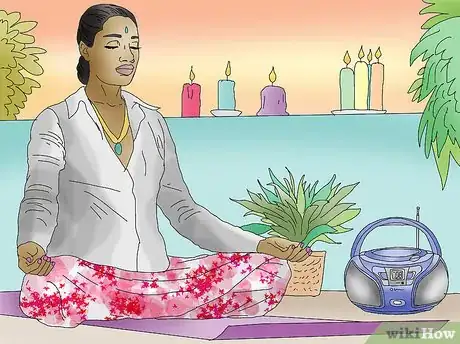
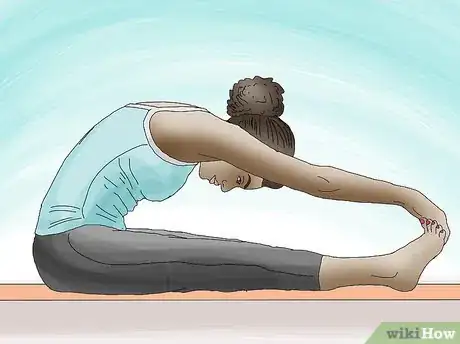
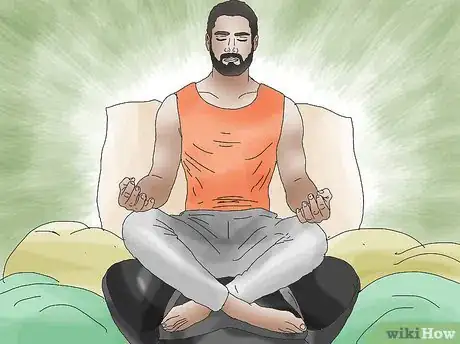







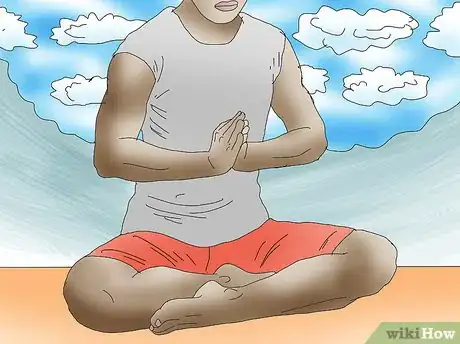
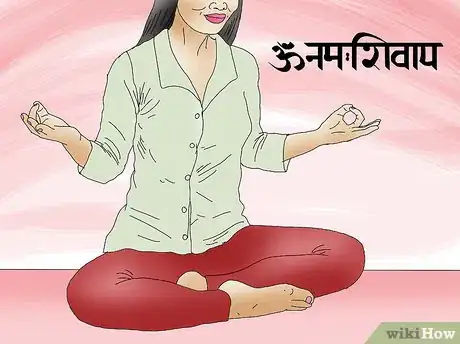

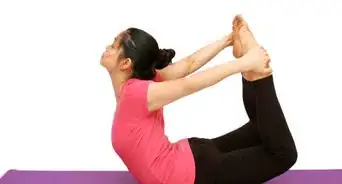









-Step-6-Version-3.webp)

















































